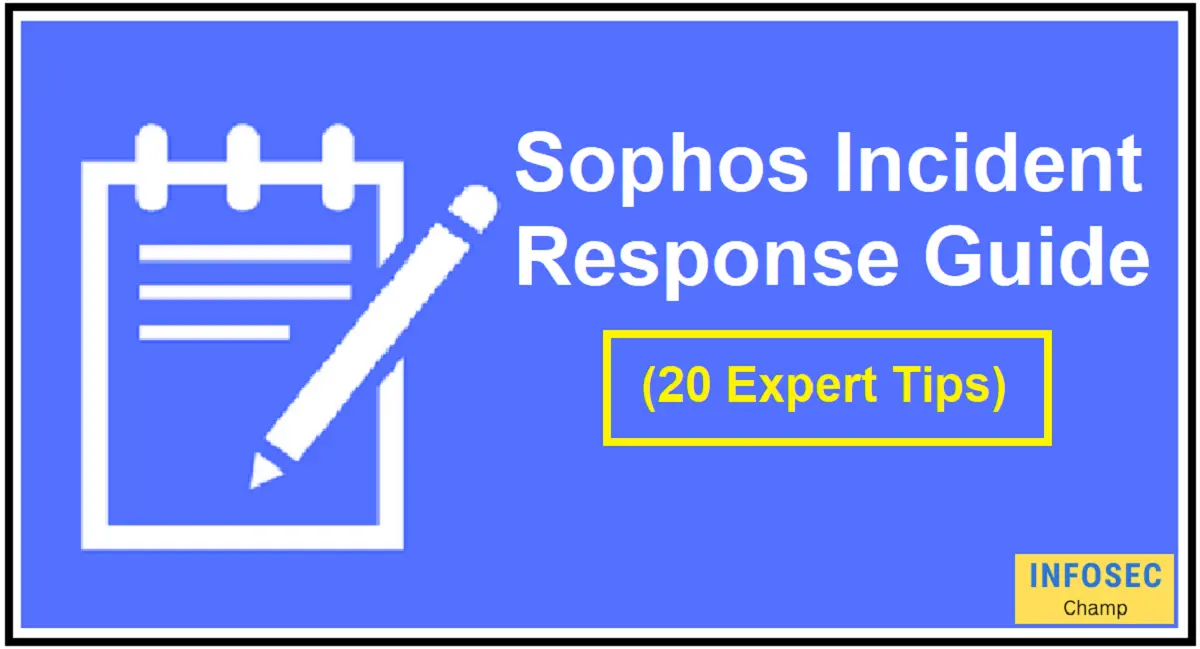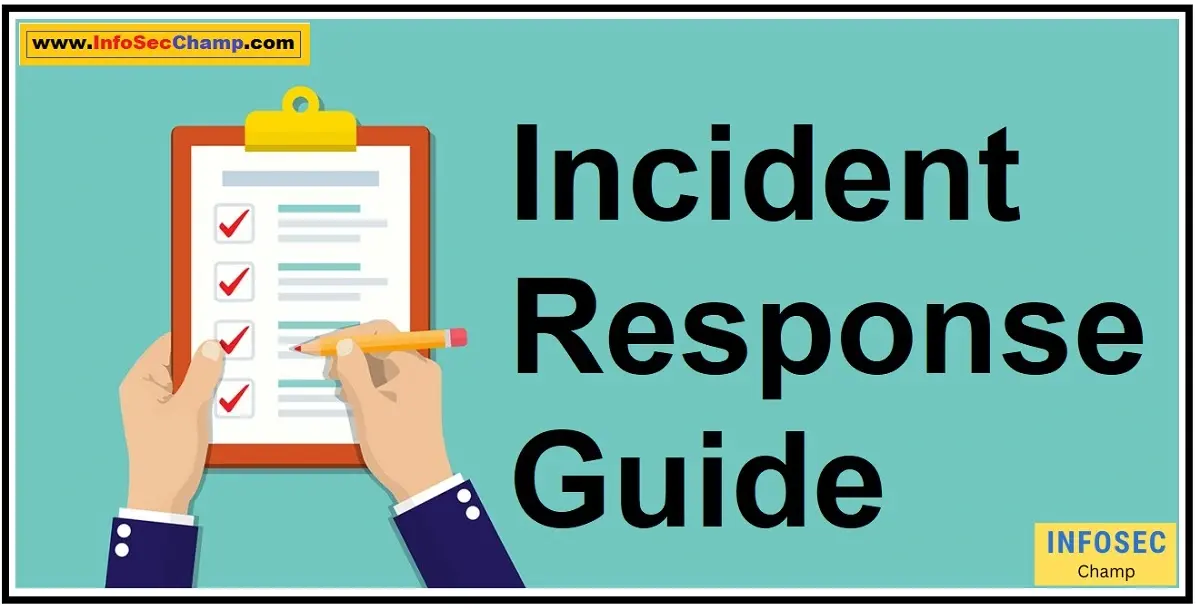The Sophos incident response guide is a comprehensive reference designed to help businesses respond to and manage cybersecurity threats. The guidebook offers helpful advice and best practices that can help companies mitigate the effects of security incidents and reduce the chance of recurrence, as well as a step-by-step approach to incident response.
The Sophos Incident Response Guide should be used by whom and for what purposes?
Any organization that wants to be ready for a cybersecurity incident should use the Sophos incident response guide as a reference. The following are some of the major organizations that stand to gain by adopting the manual:
- IT and security teams: The Sophos incident response guide gives teams in charge of IT and security the resources they require to react swiftly and successfully to a cybersecurity issue. The manual covers all aspects of an incident, including its identification, containment, eradication, and recovery.
- Executives and business leaders: Incidents involving cyber security can significantly affect an organization’s operations, reputation, and financial results. Executives and business leaders can benefit from the Sophos incident response guide by understanding the risks connected to cyber incidents and the activities they can take to reduce those risks.
- Compliance officers: The Sophos incident response guide can assist firms in meeting their incident response compliance standards. The manual offers advice on planning, recording, and reporting incident responses, all of which are important elements of many compliance frameworks.
- IT service providers: IT service providers can enhance their issue response capabilities and provide better support to their clients by using the Sophos incident response guide. The manual can assist service providers in creating incident response policies and procedures that follow accepted business standards.
For any firm that wants to be ready for a cybersecurity incident, the Sophos incident response guide is an invaluable resource. The manual offers helpful advice and best practices that can assist businesses in responding promptly and efficiently to incidents, reducing their effects, and lowering the likelihood of future occurrences.
What types of incidents does the Sophos incident response guide cover, and how does it help organizations respond to these incidents?
A wide range of cybersecurity-related situations is covered in the Sophos incident response guide. The Sophos guide can assist organizations in responding to these situations more successfully and effectively by providing guidelines and best practices for incident response.
The Sophos incident response guide covers a variety of incident categories, some of which are listed below:
- Attacks from malware and ransomware
- Social engineering and phishing attacks
- Network breaches and data theft
- Insider threats and bad behavior by employees
- DDoS assaults, or distributed denial of service attacks
- The use of advanced persistent threats and cyberespionage (APTs)
- Attacks related to cryptocurrencies, such as cryptojacking,
The Sophos incident response guide provides a variety of suggestions and best practices for each of these issue types for enterprises to adhere to. These suggestions could consist of:
- Preparing an incident response plan before an incident occurs
- Clarifying roles for incident response and channels of communication
- locating the situation and containing it as soon as possible
- Gathering and conserving proof for use in investigations and court cases
- Research and analysis of the situation in detail
- Taking steps to remediate and recover from the incident, including restoring systems and data backups
Organizations can more successfully respond to a cybersecurity event and lessen its impact by adhering to these guidelines and best practices. In addition, the Sophos incident response guide offers information and tools to help organizations with their incident response activities, including response templates, checklists for handling incidents, and access to professional guidance and assistance. For enterprises wishing to improve their incident response capabilities and better defend themselves against cyber threats, the Sophos incident response guide is a great resource overall.
When should organizations use the Sophos incident response guide, and how can it help them minimize the impact of a security incident?
When a security incident occurs, such as a cyberattack, data leak, or system failure, organizations should follow the Sophos incident response guide. The manual offers a thorough framework for handling such situations, assisting firms in reducing the negative effects on their operations, reputation, and financial stability.
- The Sophos Incident Response Guide can assist organizations in reducing the effects of a security event in the following ways:
- Outlines a step-by-step procedure for handling an event, from initial identification and containment to recovery and remediation.
- Helps businesses swiftly determine the cause of an incident and the amount of damage, allowing them to take fast action to stop it and stop further damage.
- Provides advice on how to tell others about the occurrence, such as clients, staff members, and regulators, in order to keep their trust and prevent reputational harm.
- Restoring the impacted systems, data, and applications and carrying out a thorough post-event investigation to find any areas for improvement, helps organizations recover from the incident.
- Based on the vast experience of Sophos in handling security issues, provides best practices and helpful hints for incident response.
- Helps firms create a strong incident response plan, which is an essential part of any thorough cybersecurity strategy.
Organizations may lessen the effects of a security event and make sure they are well-equipped to react swiftly and effectively to any future incidents by adhering to the criteria stated in the Sophos incident response guide. They may maintain commercial continuity in this way, stay out of legal trouble, and safeguard their reputation and financial health.

Where can organizations access the Sophos incident response guide, and what resources does it provide to help organizations respond to a security incident?
Visit the Sophos website or get in touch with a Sophos representative to get the Sophos incident response guide. The manual is a thorough resource that offers a variety of tools and knowledge to assist organizations in responding to security issues. Some of the guide’s most important sources are listed below:
- Incident response plan templates: Templates for incident response plans are provided in the manual. Creating an incident response plan is a crucial first step in reacting to a security event.
- Best practices and strategies: The manual provides advice on incident response best practices and strategies, including how to recognize and look into security incidents, stop them in their tracks and lessen their effects, and recover after one.
- Technical resources: Resources for analysis of malware, forensic evidence, and logs are among the technical resources included in the manual. These tools can assist organizations in locating the cause of a security event and taking the necessary steps to resolve it.
- Checklists and procedures: The guide offers incident response checklists and guidelines, which can help organizations organize their efforts and make sure that all relevant actions are completed.
- Training materials: To assist firms in educating their staff members on incident response best practices, the book offers training resources such as films and online courses.
- Support services: To assist enterprises in rapidly and effectively responding to security problems, Sophos also offers incident response services.
In summary, enterprises wishing to strengthen their incident response skills will find the Sophos incident response guide to be an invaluable resource. It provides a variety of resources to assist companies in identifying, analyzing, and responding to security problems, such as incident response plan templates, technical tools, and training materials. The advice is available to organizations via the Sophos website or by getting in touch with a Sophos representative.
Why is it important for organizations to have an incident response plan, and how does the Sophos incident response guide help organizations develop an effective plan?
In today’s digital environment, having an incident response plan (IRP) is crucial for any firm. A business can respond to and manage a security incident, such as a data breach or cyberattack, with the aid of an incident response plan, which is a set of written procedures.
The following list of factors highlights the significance of incident response plans for organizations:
- Minimizes the impact of a security incident: By enabling businesses to swiftly recognize and react to security risks, a well-defined IRP can help organizations lessen the impact of a security incident.
- Improves compliance: An IRP can assist firms in meeting a variety of legal obligations, including those imposed by the Health Insurance Portability and Accountability Act (HIPAA) and the General Data Protection Regulation (GDPR).
- Protects reputation: safeguards reputation Reputational damage from a security event may result for an organization. By handling incidents swiftly and skillfully, firms with an IRP in place can lessen the harm to their reputation.
- Saves time and money: Organizations can save time and money by hastening the detection and containment of security incidents with a well-defined IRP.
- Organizations can create an efficient incident response plan with the aid of the Sophos incident response guide. This is how:
- Provides a step-by-step approach: The Sophos handbook outlines a procedure for creating an incident response strategy. This can assist businesses in developing an all-encompassing incident response plan.
- Offers best practices: Best practices are provided in the Sophos guide, which also includes industry guidelines for incident response. Organizations can use this to make sure their IRP is current and functional.
- Includes templates and checklists: The manual offers checklists and templates that might assist businesses in producing an exhaustive and efficient IRP.
- Covers a range of incidents: and includes a variety of occurrences The Sophos handbook covers a variety of security problems, such as malware infections, ransomware attacks, and data breaches. This guarantees that businesses are ready for a range of security risks.
In conclusion, any firm that wants to safeguard itself against cyber attacks must have an incident response plan. A great resource, the Sophos incident response guide can assist enterprises in creating a strategy that lessens the effects of a security incident, enhances compliance, safeguards reputation, and conserves time and resources.
How can organizations use the Sophos incident response guide to prepare for a security incident, and what steps should they take to ensure they are ready to respond when an incident occurs?
Organizations must be ready for security incidents that could compromise their networks and systems given the threat environment of today. Organizations may successfully prepare for such situations and respond to them by using the Sophos incident response guide as a valuable resource. Organizations may use the Sophos incident response guide to their advantage and make sure they are prepared to react when an event arises by taking the following actions:
- Understand the contents of the guide: The Sophos incident response guide is a thorough resource that discusses various kinds of security issues and offers advice on how to handle them. The guide’s contents should be studied and understood by organizations, and they should get familiar with each of its sections.
- Develop an incident response plan: Organizations can create an incident response plan that describes the measures to be done in the event of a security incident using the Sophos guide. Preparation, detection, confinement, elimination, and recovery are some of the aspects that the strategy should include.
- Train staff on incident response: All staff members should receive incident response training so they are aware of their responsibilities in the event of a security issue. The training ought to go over how to recognize an incident, who to notify, and what to do to lessen its effects.
- Practice incident response drills: Conduct incident response drills frequently to assist firms to find weaknesses in their incident response strategy and strengthen their response capabilities. Several teams and stakeholders should participate in the drills, which should simulate different kinds of incidents.
- Maintain up-to-date cybersecurity controls: Preventing security problems requires proactive security measures. The required security controls, such as firewalls, antivirus software, and intrusion detection systems, should be in place for organizations. They should also frequently check these controls for efficacy and maintain them up to date.
In conclusion, organizations may utilize the Sophos incident response guide to plan for security issues and efficiently handle them. Organizations may enhance their security posture and lessen the effect of security incidents by creating an incident response strategy, training personnel, doing incident response drills and maintaining current cybersecurity policies.

20 Expert Tips for Getting the Most Out of the Sophos Incident Response Guide
For enterprises to manage and respond to security issues, the Sophos incident response guide is a crucial resource.
We’ve prepared 20 professional ideas to assist companies in making the most of this manual:
- Recognize the intent behind the Sophos incident response guide and how it can assist your company in handling security events efficiently.
- Learn about the many sections of the manual, such as incident investigation, communication techniques, and incident response procedure.
- Create an incident response strategy that includes the recommended procedures from the Sophos handbook.
- The incident response method outlined in the guide, which includes triage, investigation, containment, and recovery, should be taught to your incident response team.
- During an incident, use the guidance to establish clear communication methods, including who should be informed and what details should be communicated.
- Update the manual frequently to reflect evolving security risks and threats.
- To test your incident response plan and make sure it adheres to the suggestions in the Sophos guide, think about doing tabletop exercises.
- Using the best practices suggested in the guide, create a remediation plan based on the outcomes of your incident investigation.
- To help stop future incidents, put proactive security measures in place including network segmentation and user education.
- Establish a post-event review procedure using the guide to help you spot opportunities for improvement and hone your incident response strategy.
- Create an incident response checklist that is clear and succinct based on the best practices suggested in the guide.
- To manage security events effectively, create a centralized, secure incident management platform.
- For your incident response team, which should include important individuals like legal counsel and public relations specialists, use the framework to set roles and responsibilities.
- Ascertain that the resources and equipment your incident response team needs, such as forensic analysis and digital forensics tools, are available.
- Create a clear escalation procedure based on the best practices suggested in the book so that you can, if required, escalate incidents to higher levels of management right away.
- Review and update your incident response strategy and checklist on a regular basis to account for changes in the IT environment and security posture of your firm.
- Use the manual to create a thorough incident response playbook that outlines specific actions to take in response to various security problems.
- If you want to strengthen your internal issue response capabilities and have access to more knowledge, think about collaborating with a third-party incident response provider.
- Create a clear and succinct incident response communication plan using the guidance to help you reach stakeholders during an issue swiftly and efficiently.
- Finally, be abreast of the most recent security developments and new security risks so that you can be prepared to respond to security problems as they arise.
FAQ:
What are the 5 steps to incident response?
Organizations must have an incident response strategy in place to guarantee a quick and efficient response to security problems. There are five actions that can be taken for incident response, no matter what kind of incident it is:
- Preparation: Create an incident response plan that specifies team members’ roles and duties, identifies the kinds of occurrences that call for a response and offers instructions on how to respond.
- Identification: Identify the occurrence as soon as possible, along with its scope, any hazards, and any potential effects.
- Containment: To stop additional harm or the crisis from spreading, isolate the impacted systems and data.
- Eradication: Delete the event from the impacted systems, then reset them to their initial settings.
- Recovery: Return to routine activities, keep an eye out for any indicators of future events, and carry out a post-incident review to pinpoint any areas that need to be improved.
A well-thought-out and regularly used incident response plan can assist organizations in reducing the effects of a security incident and swiftly returning to normal operations. These five actions can help firms be better prepared to respond to a security incident and limit harm.
What is an incident response in Sophos?
According to Sophos, the process of locating, looking into, and addressing security incidents in an organization’s IT environment is known as incident response. Through their Sophos incident response guide, Sophos, a top provider of cybersecurity solutions, provides incident response services and advice. The following steps are often included in the Sophos incident response process:
- Preparation: Planning, identifying key players, and establishing roles and responsibilities are all aspects of preparation.
- Identification: Finding and validating one.
- Containment: Taking steps to stop the incident from spreading and to lessen its effects is known as containment.
- Investigation: Compiling facts about the occurrence in order to ascertain the attack’s breadth and underlying cause.
- Eradication: The threat is eliminated from the impacted systems.
- Recovery: Bring back regular operations for the impacted systems.
- Post-incident activities: Post-incident tasks include writing up lessons learned, doing a post-mortem analysis, and modifying the incident response strategy.

